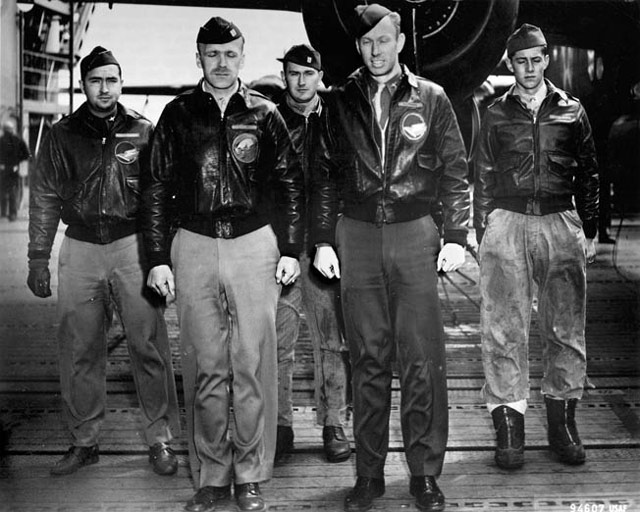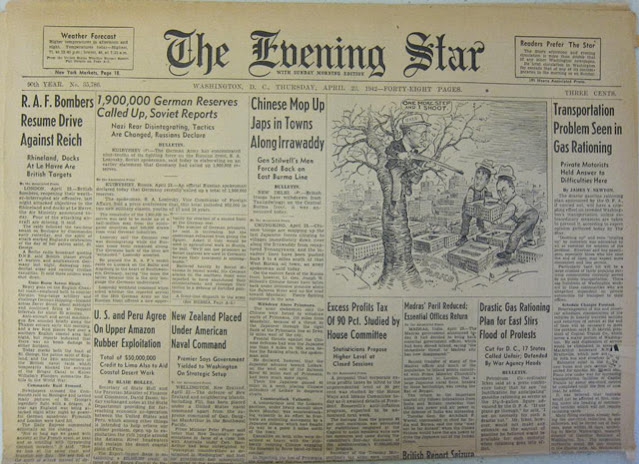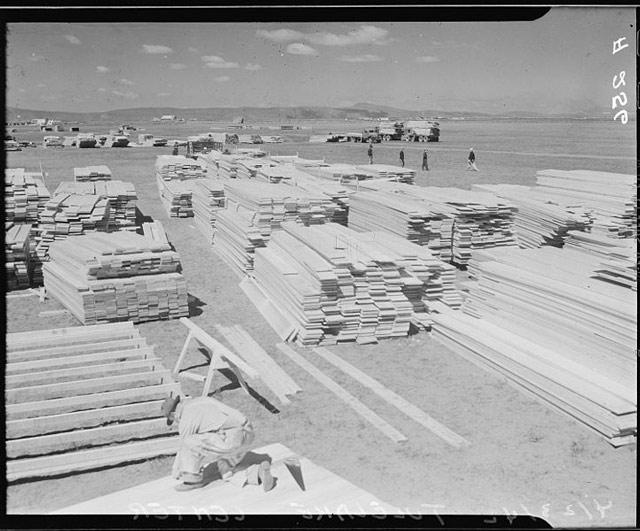Thursday 23 April 1942
Battle of the Pacific: The Soviet government announces on 23 April 1942 that one of the 18 April 1942 Doolittle Raid B-25 bombers landed at its airfield at Vladivostok. This is "Plane 8," piloted by Captain Edward J. "Ski" York and co-pilot Lieutenant Robert G. Emmens. This was the only plane that diverted from the planned landing in China and the crew wind up interned in the USSR for 13 months before an NKVD-aided escape to Iran because the Soviet Union is not at war with Japan (until August 1945).
The bombardier-navigator on the plane, Lieutenant Nolan A. Herndon, later argues (without proof) that Plane 8 was intentionally diverted to Russia under secret orders given only to the plane's pilots. This alleged mission was to test Soviet allegiance to the Allied cause and also to gather information about Soviet airfields that might be useful for later USAAF missions against Japan.
Fueling Herndon's suspicions is the very curious fact that pilots York and Emmens, much to Herndon's astonishment, turn out to be fluent Russian speakers after Plane 8 lands at the Soviet airfield. In addition, during the mission's preparation, the crew of Plane 8 was assembled at the last minute after the rest of the planes already had departed from Eglin Air Force Base for the West coast. There also are odd differences between Plane 8 and the other Doolittle bombers, such as different tuning of its carburetors, as if it was never intended to fly the same flight path as the other bombers.
This leads to an enduring mystery of World War II as to whether Plane 8's pilots were ordered to fly to Vladivostok instead of China. There is no proof of an intentional diversion despite all of the suspicions, and one would think that the navigator would be part of the "plot" instead of just the pilots. Asked point-blank about this years later, Jimmy Doolittle and others involved evaded the question without outright denying the allegation ("I did not send you to Russia" is all that Doolittle would say). This controversy plays out for decades, mostly within the tight-knit community of Doolittle Raid crewmen but also lovers of a good mystery.
Battle of the Indian Ocean: In Burma, the Japanese 56th Division continues advancing from Taunggyi toward Lashio, Burma. The Chinese defenders of Taunggyi, meanwhile, retreat in the direction of Yunnan Province. The 10th Air Force of the USAAF continues evacuating personnel and supplies from Burma to India. There are reports out of India of increased fears of a Japanese invasion there.
 |
| Luftwaffe reconnaissance taken on 23 April 1942 of the North Bay of Sevastopol, showing numerous large fortresses. Large Soviet forces are holding out in Sevastopol while German General Manstein's 11th Army prevents relief from Soviet forces to the east (Federal Archives Image 168-278-011). |
Eastern Front: General Halder merely notes in his war diary, "Situation unchanged, a curiously quiet day on the entire front." Colonel Hans Speidel reports today to Halder after his transfer to the Eastern Front from France to become the Chief of Staff of the 5th Army Corps. The Luftwaffe launches three raids against Murmansk and sinks a floating crane and a tugboat, among other damage.
The Soviet Stavka (high command) relieves General Meretskov as commander of the Volkhov Front. Large Red Army forces are trapped on the western side of the Volkhov River and Meretskov essentially becomes the scapegoat. The entire command is subordinated to Headquarters, Leningrad Front. In Leningrad, General Khozin is ordered to break the Leningrad siege. Unfortunately for the Soviets, the spring thaw ("Rasputitsa") already has created a channel in the middle of the Volkhov River and the Soviets on the eastern bank are no longer to supply the pocket to the west. Inside the pocket, General Vlasov's Second Shock Army is starting to give ground against sustained German pressure, so time is running out for the Soviets.
European Air Operations: The Luftwaffe and RAF stage raids tonight that exhibit the same characteristics and similarly negative results. Both raids are against medium-sized historic towns by a medium-sized bomber force led by a handful of bombers equipped with special navigational equipment. They cause little damage of note. These similarities are an indication of temporary parity in the air war.
The so-called "Baedeker Raids" begin today. They are launched by the Luftwaffe against mid-sized English towns that coincidentally feature prominently in guidebooks. Exeter is tonight's target. Other cities on the list will include Bath, Canterbury, Norwich, and York. These raids are in retaliation for a heavy 28 March 1942 RAF air raid on the historic German city of Lubeck. Tonight's raid by 45 Do 217s of KG 2 and Ju 88s of KG 106 against Exeter causes little damage, but the Luftwaffe plans a follow-up raid on the night of the 24th. They are led to the target by a few specially equipped He 111s of 1./KG 100.
The RAF, meanwhile, makes the first of a series of four raids against the Baltic port town of Rostock. This is somewhat ironic, as Rostock has many similarities to Lubeck, the raid against which caused such ire in the German high command. Rostock has few air defenses and the RAF bombers are guided by pathfinder bombers using the Gee navigational system. The goal of 18 bombers is a precision attack on the Heinkel aircraft factory on the southern outskirts of town, while 143 others bomb the center of town (Altstadt). The raid is a failure, with no hits scored on the Heinkel factory and most of the other bombers missing the town by two to six miles. The RAF loses two Wellington bombers, a Manchester bomber, and a Whitley bomber for these tepid results.
 |
| Two US Navy Yeomen hold a battered flag that was flying in Pearl Harbor at the time of the 7 December 1941 attack. That are at a Naval recruiting office at Kansas city on 23 April 1942 (AP Photo). |
Battle of the Atlantic: German motor torpedo boat Esau (LS-4), operating from auxiliary cruiser SS Michel, torpedoes and sinks 8684-ton US tanker Connecticut in the South Atlantic midway between Brazil and Angola. There are 36 deaths and 18 survivors. Michel rescues the survivors and later turns them over to the Japanese as POWs when docked in Yokohama.
U-125 (Kptlt. Ulrich Folkers), on its fourth patrol out of Lorient, torpedoes and sinks 5102-ton US freighter Lammot Du Pont about 500 nautical miles (930 km) southeast of Bermuda. There are 37 survivors and 17 deaths. USS Tarbell and Swedish freighter Astri rescue the survivors.
Soviet submarine Shch-401 attacks a German convoy off Tanafjord, Norway. It torpedoes and sinks 1359-ton Norwegian liner Stensaas off Slettnes in the Barents Sea. German submarine chaser UJ-1101 rescues the survivors. UJ-1101 and UJ-1110 drop depth charges on the submarine, which temporarily escapes with some damage but later sinks.
British 2768-ton collier Chatwood hits a mine and sinks in the North Sea off Cromer, Norfolk. All 24 crewmen survive. Salvage attempts are made in 1994 by "Desert Star."
US destroyer USS Geer (DD-145) rescues survivors of US freighter Robin Hood, sunk by U-575 on 15 April 1942. Destroyer Rowan (DD-405) rescues the survivors of US freighter San Jacinto, sunk by U-201 on 21 April.
 |
| US freighter Lammot Du Pont, sunk by U-125 southeast of Bermuda on 23 April 1942. |
Battle of the Mediterranean: U-565 (Kptlt. Wilhelm Franken), on its fifth patrol out of La Spezia, attacks convoy TA 36 and sinks 1361-ton British freighter Kirkland about 35 nautical miles (65 km) northwest of Sidi Barrani, Egypt. There are 22 survivors and one death. HMT Falk rescues the survivors.
British 4986-ton freighter Jersey hits a mine and sinks in the Red Sea off Suez, Egypt.
At Malta, large Axis air formations attack Grand Harbour installations and the airfields around 11:00. Another large raid is at 15:30. The RAF defenders are down to two operational Spitfires of No. 601 Squadron at Luqa and four Hurricanes of No. 229 Squadron at Hal Far.
Civilian workers are convinced to work repairing airfields at Ta Qali and Luqa despite the oppressive daily Luftwaffe attacks. Detachments of Malta Police also help out. There are plans to compel such assistance in the future under the Compulsory Service Scheme, when they (and next of kin) will receive additional benefits.
 |
| The Daily Mirror focuses on a unique angle of the inconclusive Operation Abercrombie commando raid on the French shore near Boulogne on the night of 21/22 April 1942. |
South African/French Relations: South Africa severs diplomatic relations with Vichy France.
British Government: Lord Portsea makes a speech requesting that humanitarian aid be sent to the Channel Islands of Jersey and Guernsey despite the German occupation. No decision is made.
Prime Minister Winston Churchill speaks at a Secret Session of the House of Commons about the fall of Singapore in February 1942. It is one of Churchill's longest wartime speeches and very candid about the true situation in the Far East.
German Homefront: Reich Plenipotentiary for Labour Fritz Sauckel issues a decree for schoolboys aged 14-16 and schoolgirls aged 16-17 to work on farms. Many of the boys, however, already are manning antiaircraft guns.
Reich Finance Minister Count Lutz Schwerin von Krosigk gives a speech to the German Chamber of Commerce in Amsterdam about the Reich's economy. Krosigk claims that the trick to avoiding inflation is to absorb excess buying power. This trick, he says, will enable the German people to avoid economic dependence on the rest of the world.
British Homefront: Crime writer and poet Dorothy L. Sayers gives an address at Eastbourne entitled "Why Work?" She argues that a post-war British economy should not be driven by capitalist consumerism but instead by matching workers with jobs based on talent and intention. It is a vaguely socialist vision that is gradually gaining a foothold within England amidst the deprivations of war.
American Homefront: Construction begins today at the Tule Lake Relocation Center in Newell, California. This is a high-security camp for internees considered a particular threat (for refusing to renounce the Japanese Emperor, for instance), with three layers of barbed-wire fences and armed guards with orders to shoot anyone trying to break out. The morale there becomes notoriously low, with many residents becoming militant and intentionally trying to provoke the guards.
April 1942
April 1, 1942: Convoys Come to the USAApril 2, 1942: Doolittle Raiders Leave Port
April 3, 1942: Japanese Attack in Bataan
April 4, 1942: Luftwaffe Attacks Kronstadt
April 5, 1942: Japanese Easter Sunday Raid on Ceylon
April 6, 1942: Japanese Devastation In Bay of Bengal
April 7, 1942: Valletta, Malta, Destroyed
April 8, 1942: US Bataan Defenses Collapse
April 9, 1942: US Defeat in Bataan
April 10, 1942: The Bataan Death March
April 11, 1942: The Sea War Heats Up
April 12, 1942: Essen Raids Conclude Dismally
April 13, 1942: Convoy QP-10 Destruction
April 14, 1942: Demyansk Breakout Attempt
April 15, 1942: Sobibor Extermination Camp Opens
April 16, 1942: Oil Field Ablaze in Burma
April 17, 1942: The Disastrous Augsburg Raid
April 18, 1942: The Doolittle Raid bombs Japan
April 19, 1942: British in Burma Escape
April 20, 1942: The Operation Calendar Disaster
April 21, 1942: Germans Relieve Demyansk



No comments:
Post a Comment